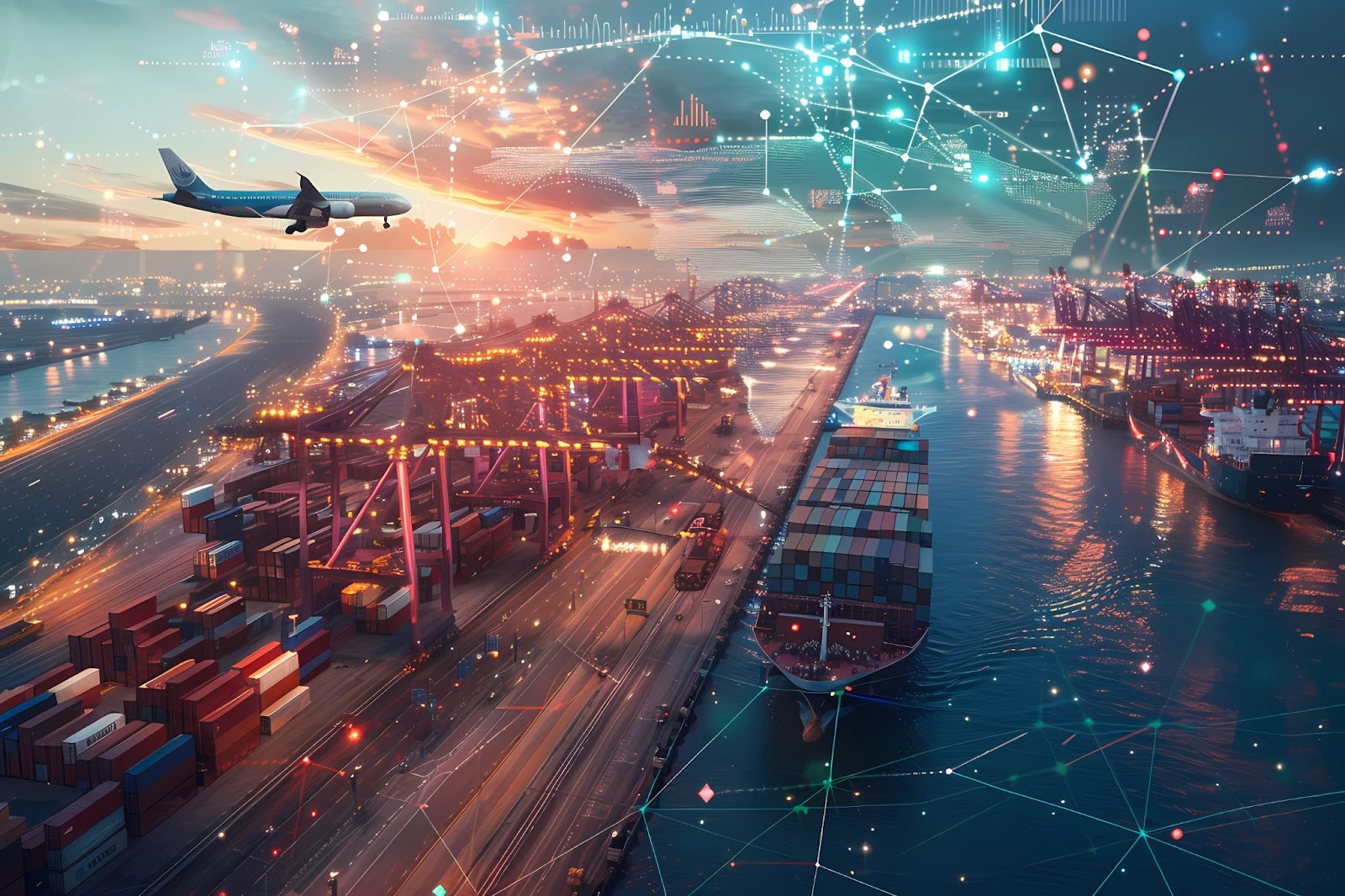Optimize your business: use unlimited savings with Pazago fulfilled now!
Get Started ->If you're running an export business, you know just how unpredictable international trade can be. From shifting government regulations to changing shipping costs, global trade is influenced by numerous pressures. Understanding the key factors that affect international trade is essential for planning more effectively, negotiating better rates, and staying ahead of the competition.
According to the World Trade Organisation, global merchandise trade is expected to decline by 0.2 percent in 2025, and could fall by as much as 1.5 percent if current tariff disputes escalate.
This outlook highlights just how quickly trade flows can be disrupted. That makes it even more important for businesses to stay informed and agile.
In this blog, we will explore the most influential factors affecting international trade and how they impact your operations.
TL;DR
- Economic conditions like currency fluctuations, inflation, and GDP growth shape international trade demand and pricing.
- Political and regulatory factors such as trade agreements, tariffs, and sanctions impact market access and compliance.
- Logistics and infrastructure efficiency affects shipment costs, timing, and supply chain reliability.
- Technological advances streamline trade processes with automation, blockchain, and real-time tracking.
- Environmental and cultural considerations influence buyer expectations, sourcing decisions, and communication in global markets.
What is International Trade Flow?
International trade flow refers to the movement of goods and services across international borders. It helps you track the exchange of products between countries, including the volume, direction, and value of imports and exports.
By understanding trade flows, you can make better decisions about where to expand, how to manage pricing, and when to adjust your sourcing or logistics strategy. These flows are shaped by various factors such as trade agreements, exchange rates, demand and supply shifts, and regulatory changes.
If you are part of the global trade ecosystem, staying informed about international trade flow gives you a clearer view of market trends and helps you stay prepared in a constantly evolving environment.
Now, let’s take a closer look at how various economic conditions, like inflation, interest rates, and national income levels, play a defining role in shaping international trade patterns.
Also Read: Understanding Different Types of International Trade
Economic Factors that Impact International Trade Flows
When you participate in international trade, the economic conditions of both your home country and your trading partners significantly influence your business performance. Understanding these economic factors helps you anticipate challenges and identify opportunities in global markets.
Here are some key economic factors affecting your trade activities:
- Exchange Rates and Currency Volatility
Currency values fluctuate constantly. If your local currency strengthens against a foreign currency, your exports may become more expensive and less competitive abroad. Conversely, a weaker local currency can make your products more affordable to international buyers. Monitoring these changes enables you to adjust pricing strategies and hedge against risks effectively.
- Inflation and Interest Rates
Inflation impacts the purchasing power of your customers in foreign markets. High inflation may reduce demand for your products. Interest rates affect borrowing costs for businesses and consumers, influencing spending patterns. Both factors can shape the volume and profitability of your trade.
- Economic Growth and GDP
The overall health of an economy is reflected in its Gross Domestic Product (GDP). Rapid economic growth in your target markets often signals increasing demand for goods and services. In contrast, a slowdown or recession can lead to reduced imports. Keeping track of GDP trends allows you to align your export efforts with market potential.
- Economic Stability
Political and economic stability are critical for reliable trade. Countries experiencing economic uncertainty or crises may impose restrictions, face supply disruptions, or experience fluctuations in demand. Being aware of such risks helps you avoid unexpected losses.
By paying attention to these economic indicators, you can make informed decisions about where to focus your efforts, how to price your products, and when to enter or exit certain markets. This strategic approach can improve your competitiveness and profitability in international trade.
To navigate these economic shifts confidently, Pazago offers real-time market intelligence and insights tailored for Indian exporters. Stay informed and make smarter trade decisions with Pazago by your side.
Government decisions and regulations also play a major role in international trade. Let’s take a look at that in the next section.
Political and Regulatory Factors Shaping Your International Trade
Political decisions and government regulations play a crucial role in how smoothly your cross-border trade operates. Changes in policies or rules can create opportunities but also bring challenges that you need to manage carefully.
Key political and regulatory factors to consider include:
- Trade Agreements and Tariffs
Governments negotiate trade agreements that can lower or remove tariffs between countries. These agreements make it easier and more cost-effective for you to export or import goods. However, new tariffs or changes in agreements can suddenly increase costs or restrict market access.
- Sanctions and Embargoes
Political tensions may lead to sanctions or embargoes against certain countries or businesses. These restrictions can block trade altogether, so staying updated helps you avoid legal risks and ensure compliance.
- Custom Duties and Import/Export Restrictions
Import and export duties vary by product and country. Additional restrictions, such as quotas, licensing, or documentation requirements, may also apply. Understanding these rules allows you to plan better and avoid costly delays or penalties.
- Political Stability
Political stability affects trade reliability. Countries experiencing unrest or frequent policy changes may face supply chain disruptions or sudden regulatory shifts. Keeping informed about political developments helps you anticipate risks.
Understanding these factors effectively requires staying current and adapting quickly. This can be complex, but with the right support, you can minimize disruptions and maintain smooth trade operations.
Ensure every shipment meets compliance standards by using Quality Inspection to catch issues early and ship with confidence, regardless of the regulatory landscape.
In the next section, we’ll focus on how infrastructure and logistics can strengthen or slow down trade operations.
Also Read: Import and Export Trade: Understanding Its Impact and Strategies In India
Logistics and Infrastructure Impacting Your International Trade
Efficient logistics and reliable infrastructure are the backbone of successful international trade. When these systems function effectively, your shipments arrive on time, costs remain manageable, and your customers remain satisfied. On the other hand, delays or disruptions can quickly erode your reputation and cut into your profits.
Here are the key logistics and infrastructure factors you should consider:
- Shipping Costs and Container Availability
The cost of shipping goods can vary greatly depending on global demand, fuel prices, and seasonal fluctuations. For example, during the COVID-19 pandemic, container shortages and port congestion led to a surge in shipping rates, making it more expensive to move goods internationally.
If you are unaware of such changes, you might face unexpected costs or delays. Monitoring these trends helps you plan budgets better and negotiate smarter with freight providers.
- Port Efficiency and Capacity
Ports are crucial gateways for trade. Efficient ports, equipped with modern cranes, automated handling systems, and adequate storage, reduce turnaround times.
In contrast, ports with congestion or limited capacity can cause shipments to accumulate, resulting in prolonged waiting times and increased storage fees. Knowing which ports your goods will pass through helps you anticipate and mitigate delays.
- Supply Chain Disruptions
Unpredictable events, such as natural disasters, political unrest, or health crises, can have a severe impact on supply chains. For example, the 2021 blockage of the Suez Canal halted billions of dollars in trade for several days, affecting shipments worldwide.
Similarly, labour strikes at major ports can delay cargo handling. Building flexibility into your logistics plans and having backup routes or suppliers is critical to maintaining business continuity.
- Transport Infrastructure Quality
Once your goods arrive at the ports, their journey is not over. The quality of roads, railways, and airports determines how quickly and safely products reach their final destination.
For example, poor road conditions in certain regions can cause delays and increase the risk of damage to fragile goods. Investing time in choosing reliable inland transport partners or using multimodal transport solutions can improve delivery times and reduce risks.
- Technology and Real-Time Tracking
Modern logistics also relies on technology. Real-time shipment tracking, digital documentation, and automated customs clearance systems make managing international shipments more transparent and efficient.
For example, some advanced logistics providers like Pazago offer an end-to-end tracking feature that alerts you immediately to any delays or issues. This level of visibility helps you proactively address problems before they affect your customers.
By considering these logistics and infrastructure factors, you can develop a resilient supply chain that withstands disruptions, controls costs, and supports your business growth.
Moving on, let’s see how technology is changing the way international trade works.
Technological Advancements for Your International Trade

Key technological developments impacting your trade include:
- Automation and Digitization
Manual paperwork and slow procedures can slow down your trade operations. Automation tools help streamline documentation, customs clearance, and order processing. For example, electronic data interchange (EDI) allows instant sharing of trade documents, reducing errors and speeding up approvals. Digitizing these workflows saves you time and lowers the chance of costly mistakes.
- Blockchain Technology
Blockchain provides secure and transparent record-keeping for trade transactions. It simplifies tracking the origin and movement of goods, helping ensure authenticity and compliance. Many supply chains use blockchain to speed up payments and reduce fraud by providing a trusted ledger accessible to all parties involved.
- Real-Time Tracking and IoT Devices
Sensors and GPS trackers offer real-time updates on your shipments. You can monitor location, temperature, humidity, and other important factors, especially for sensitive items like pharmaceuticals or perishables. This information helps you maintain product quality and respond quickly if any problems arise during transit.
- E-commerce and Digital Trade Platforms
The rise of online marketplaces has opened up global trade opportunities, especially for small and medium exporters. These platforms enable you to reach buyers worldwide with less upfront investment. They often include payment processing, logistics, and compliance tools to make international selling easier.
By adopting these technologies, you improve efficiency, reduce risks, and provide better service to your customers. Keeping up with new tools is essential to staying competitive and growing your trade business.
In the next section, we’ll discuss why sustainability and environmental standards matter more than ever in global trade.
Environmental and Sustainability Pressures Impacting Your International Trade
Sustainability is becoming a key factor in global trade decisions. Buyers, governments, and partners increasingly expect businesses to operate responsibly and reduce their environmental impact. Understanding these pressures helps you align your trade practices with market expectations and regulations.
Here are the main environmental and sustainability factors affecting your trade:
- Carbon Emission Regulations
Many countries are implementing rules to limit carbon emissions from manufacturing, transportation, and packaging. Compliance with these regulations can affect your choice of suppliers, shipping methods, and materials used in your products.
- Sustainable Sourcing
Buyers are demanding products made with sustainable materials or ethical labor practices. Showing that your goods meet these standards can open new markets and improve your brand reputation.
- Environmental, Social, and Governance (ESG) Certifications
Certifications related to ESG criteria are becoming important in many industries. These labels demonstrate your commitment to responsible business practices and are often required by international buyers or financial institutions.
- Shifts in Buyer Behaviour
Consumers are increasingly choosing eco-friendly products. Businesses that adapt to this trend can gain a competitive edge by offering greener options and transparent supply chains.
- Waste Reduction and Circular Economy
Efforts to reduce packaging waste and promote recycling are influencing how products are designed and shipped. Adopting circular economy principles can help you meet regulatory requirements and customer expectations.
By addressing these sustainability challenges, you can not only comply with regulations but also build trust and long-term relationships with global partners.
Moving on, let’s understand how cultural and social elements shape your trade relationships.
Social and Cultural Factors Influencing Your International Trade
Understanding social and cultural differences is essential when you trade across borders. These factors affect how your products are perceived, how you communicate with buyers, and ultimately, your success in foreign markets.
Key social and cultural considerations include:
- Consumer Preferences and Trends
Different markets have unique tastes and buying habits. For example, packaging that appeals in one country may not work in another. Tailoring your products to local preferences helps increase acceptance and sales.
- Cultural Norms and Traditions
Customs around business communication, negotiations, and marketing vary widely. Knowing and respecting these norms builds trust and smooths interactions with your international partners.
- Language and Communication
Language barriers can lead to misunderstandings or delays. Providing clear, culturally sensitive information and utilising translation services when necessary ensures effective communication and reduces errors.
- Local Holidays and Festivals
Awareness of important local dates helps you plan shipments, marketing campaigns, and customer service accordingly, avoiding disruptions or missed opportunities.
- Social Values and Ethical Expectations
Social attitudes toward labour practices, environmental responsibility, and corporate behaviour can influence buyer decisions. Demonstrating alignment with these values strengthens your brand image.
By paying attention to these social and cultural factors, you improve relationships, avoid costly mistakes, and enhance your global trade performance.
Next, see how Pazago helps you handle documentation, inspections, and logistics, so you can export with fewer delays and more confidence.
Why Indian Exporters Choose Pazago for Global Trade

Pazago helps Indian exporters manage international trade with greater efficiency and clarity. Whether you're expanding to new markets or improving existing operations, our tools are built to support you at every step.
Here’s what you can expect with Pazago:
- Access to real-time trade insights: Make better decisions with up-to-date information on market trends, buyer behaviour, and regulatory updates.
- Centralized Document Management: Store and manage all port-related documents such as bills of lading, customs clearances, and payment receipts securely in one place.
- Better visibility and control over logistics: Monitor your shipments, plan routes more efficiently, and respond quickly to disruptions.
- Affordable Logistics Solutions: Optimize shipping routes and costs to improve delivery timelines.
- Expert Support: Access insights and recommendations from logistics experts to negotiate better rates and avoid hidden port charges.
- Pre-Shipment Quality Checks: Avoid claim rejections by ensuring your goods meet international quality standards before they’re dispatched. Pazago offers pre-shipment inspection support, reducing the likelihood of delivery disputes and product returns.
- Integrated Insurance Access: With built-in insurance services, Pazago helps you get covered quickly and manage policies from a single dashboard. When it’s time to file a claim, you can easily refer to your coverage details and initiate the process without delays.
Pazago supports exports to over 110 countries, delivering up to 20% in cost savings and reducing turnaround time by 50%, enabling faster and more efficient international trade for exporters.
Conclusion
International trade is influenced by many real-world factors such as market conditions, government policies, infrastructure, and buyer expectations. To succeed in this space, you need to stay informed, plan ahead, and make data-driven decisions.
Understanding these factors can help you avoid delays, reduce costs, and respond to changing regulations more effectively. It also gives you a clearer picture of where to focus your efforts for long-term growth.
Ready to simplify how you manage exports? Pazago gives you the tools, insights, and support to handle global trade with greater speed, accuracy, and confidence. Book a demo today and talk to one of our experts.
Frequently Asked Questions (FAQs)
1. What are the main factors affecting international trade?
The main factors you need to watch include economic conditions, political and regulatory policies, logistics and infrastructure, technology, environmental and sustainability pressures, and social and cultural differences.
2. How do exchange rates impact your international trade?
When exchange rates change, they affect how competitive your products are. If your local currency gets stronger, your exports may become more expensive for buyers abroad. If it weakens, your products can be more affordable to them.
3. Why should you pay attention to trade agreements?
Trade agreements help reduce tariffs and barriers, making it easier and cheaper for you to buy and sell goods across borders.
4. How can logistics affect your export business?
Good logistics mean your shipments arrive on time and costs stay low. Problems such as port delays, container shortages, or poor transportation routes can cause costly delays for you.
5. Why is sustainability important for your global trade?
More buyers and governments expect you to operate responsibly and reduce environmental impact. Meeting these standards helps you access new markets and build a stronger brand.
6. How do cultural differences affect your trade?
Understanding local preferences, communication styles, and business customs helps you build trust, avoid mistakes, and improve sales in foreign markets.


.png)








